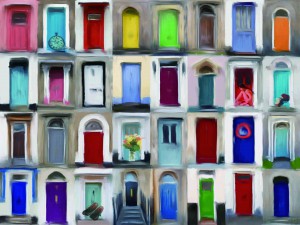Voiceless Temples of the Soul by Stefan Saskov
TEMPLES ABANDONED
The tragedy of abandonment one confronts in these darkly glowing images struck me immediately with overwhelming force. After I had begun to recover from the shock I was able to see hope for humanity and to admire the great beauty of Stefan Shaskov’s photography of the light of the candles reflected in silver crucifixes , abandoned chandeliers and the eyes of portraits of saints, in pieces of glass. Stefan’s chiaroscuro photos seem to be lit from within like the El Greco’s paintings of Saint Francis or his Christ on the cross (c.1600-1610, El Greco had been Getty Museum). In Spain the Council of Trent had recommended for painters that St. Francis be represented more simply to encourage a contemplative attitude conducive to daily meditation’ – Did Stefan observe this injunction in his photographs of the abandoned?
My favorite image is that of a brilliantly translucent white light bulb hanging in front of Crucifixion scene in which the concept of neglect and abandonment takes on complex layers of meanings. The photo can remind one of the photo of a light bulb above the head of a beautiful woman by Ed Van Der Elsken, Love on the Left Bank.
The art and objects which have been abandoned here appear to be vaguely related to a late Byzantine style and perhaps religious rituals which one can find in other abandoned examples of churches , for example the murals in the side chapel of the Church of the Chora in Istanbul (c. 1310-20) or the Convent Church in Daphne in Greece.
In these photographs, abandonment evokes feelings of nostalgia , longing, which allows time to destroy a certain beauty but somehow permits the past to vanish gracefully.
Hans Guggenheim
Voiceless Temples of the Soul
Silence is not merely the absence of sound, noise or providence. Silence is food placed on the limitless interstellar table in the mystic chamber of the heart, still present in the silent echo of the old church bells in the dark domes of the world. It exists where the phenomenal had given eternal non-place to the noumenal. There, where human dreams interfere with sleep and where the desire of what has never been becomes part of what once existed and is now past. It is the food provided to us by the intermedia creator, our friend Stefan Saskov through a luminal perspective of this photographic cycle.
By observing these excerpts of eternity, with the patience of a mountain or a planet, it is as if we become aware of the divine gift of finality, whose harbinger defines all our fleshly existence: – Will I, at the end of my unique and personalized time, meet peace or emptiness? Hence the vital provocation in these scenes, as the author-photographer had contemplated them, is given to us as a reminder or roadmap, hidden behind layers of soot, shadows and non-action for what is really alive within us. Beauty deprived of time. It is precisely the eschatonic cry of the archangel: – Time will be no more !!! – we are pierced by these wonderful documents of existence. Every cry echoes in them, every pain disappears, every prayer is answered, every wish has died, every hope is drained, every tear has dried up, and peace has remained. For us, it is a gift. For the author, it is eternal crucifixion.
Father Methodius Zlatanov
(translated by Melentie Pandilovski)


